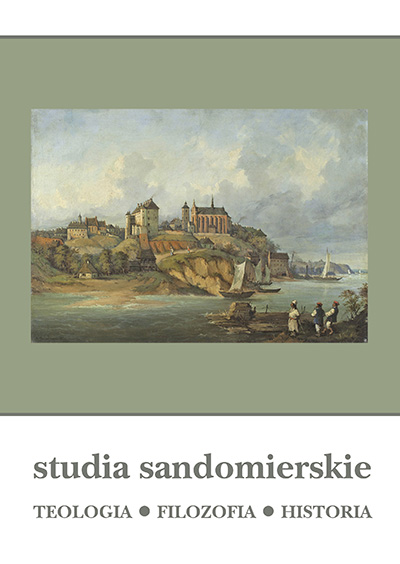Prospettiva cristocentrica della creazione nel Nuovo Testamento
DOI:
https://doi.org/10.15633/sts.4185Słowa kluczowe:
Jezus Chrystus, Nowy Testament, teologia stworzeniaAbstrakt
Nauczanie Nowego Testamentu w zakresie teologii stworzenia koncentruje się na wydarzeniu Jezusa Chrystusa. Pisma Nowego Testamentu ukazują „Boga, który ożywia umarłych i powołuje do istnienia to, czego jeszcze nie ma” (Rz 4,17). Przesłanie Nowego Testamentu przedstawia zbawcze działanie Boga w Jezusie Chrystusie, także w kontekście teologii stworzenia. Wzajemna korelacja stworzenia i historii zbawienia jest niezbędna dla zrozumienia przesłania teologii stworzenia, które w rzeczywistości osadza się na zapowiedzi odkupienia dokonanego przez Jezusa Chrystusa. Innymi słowy, refleksja nad stworzeniem wypływa z refleksji nad zbawieniem, które jest nierozerwalnie związane z wydarzeniem Chrystusa. Uznanie Chrystusa za jedyny „początek i koniec” wszystkich rzeczy, kieruje nasze spojrzenie w kierunku obietnicy odkupienia stworzenia od wszelkich przejawów zła, które dotyka je obecnie. Jest jednocześnie zaproszeniem do odrzucenia wszelkiego dualizmu. Nie można zatem „odrywać” od siebie porządku „natury” oraz „łaski i prawdy”, z drugiej zaś strony, nie oznacza to wszystko prostej identyfikacji tych dwóch porządków.
Bibliografia
AA.VV., Nuovo corso di dogmatica. Dottrina della creazione, a cura di G. Canobbio, A. Maffeis. Brescia 1995.
Aletti J.N., Colossiens 1, 15–20. Genre et exégèse du texte. Fonction de la thématique sapientielle, Roma 1981.
Aletti J.N., Saint Paul. Épître aux Colossiens, Paris 1993.
Amato A., Gesù il Signore. Saggio di Cristologia, Bologna 19974.
Associazione Biblica Italiana, La cristologia in San Paolo. Atti della XXIII Settimana Biblica, Brescia 1976.
Aurrecoechea J.L., Los tίtulos cristológicos de Colosenses 1,15–16. Su origen y su significado, “Estudios Trinitarios” 8 (1974), p. 307–328.
Barbaglio G., Creazione, in Nuovo Dizionario di Teologia, a cura di G. Barbaglio
e S. Dianich, Roma 19947, p. 200–213.
Bartnik Cz., Dogmatyka katolicka, vol. 1, Lublin 1999.
Benoit P., Préexistence et incarnation, “Revue Biblique” 77 (1970), p. 5–29.
Bordoni M.-Ciola N., Gesù nostra speranza. Saggio di escatologia, Bologna 1998.
Bruce F.F., The Epistles to the Colossians, to Philemon, and to the Ephesians, Grand Rapids 1984.
Burger C., Schöpfung und Versöhnung. Studien z. Liturgischen Gut im Kolosser – und Epheserbrief, Neukirchen Verlag 1975.
Cipriani S., Cristo „Potenza di Dio e Sapienza di Dio” in 1 Cor 1, 24, in Associazione Biblica Italiana, La Cristologia in San Paolo. Atti della XXIII Settimana Biblica, Brescia 1976, p. 341–360.
De La Potterie I., Studi di cristologia giovannea, Genova 1986.
Delmirani M., Creazione in Cristo. Aspetti fondamentali di Teologia biblica sulla Creazione, Roma 1986.
Feuillet A., Il prologo del quarto vangelo, Assisi 1971.
Feuillet A., La profession de foi monothéiste de 1 Cor 8, 4–6, in: Le Christ Sapesse de Dieu, Parigi 1966, p. 59–85.
Gnilka J., Der Epheserbrief, Freiburg 1982.
Grillmeier A., Gesù il Cristo nella fede della Chiesa, vol. 1, Dall’età apostolica al concilio di Calcedonia (451), Brescia 1982, p. 143–167.
Kijas Z.J., Początki świata i człowieka, Kraków 2004.
Lyonnet S., Ruolo cosmico di Cristo in Col. 1, 15ss. alla luce del ruolo cosmico della Torà nel giudaismo, in: AA.VV., La Cristologia in San Paolo. Atti della XXIII Settimana Biblica, Brescia 1976, p. 57–79.
Martinez Camino J.A., “A przez Niego wszystko się stało”. Stworzenie w Chrystusie, “Communio” 22 (2002), vol 2, p. 14–28.
Mateos J. – Barreto J., Dizionario teologico del Vangelo di Giovanni, Assisi 1982, p. 56–65.
Mitton C.L., Ephesians, Greenwood 1976.
Moltmann J., Futuro della creazione, Brescia 1980.
Neyrand G., Le sens des “logos” dans le prologue de Jean, “Nouvelle Revue Théologique” 106 (1984), p. 59–71.
O’Collins G., Cristologia. Uno studio biblico, storico e sistematico su Gesù Cristo, Brescia 1997.
Otero Lazaro T., Col 1, 15–20 en el contexto de la carta, Roma 1999.
Penna R., Infrazione e ripresa del rapporto Legge-sapienza in Paolo, in: AA.VV., Sapienza e Torah. Atti della XXIX Settimana Biblica, Bologna 1987, p. 126–151.
Rad von G., Teologia dell’Antico Testamento, vol. 1, Brescia 1974.
Rey B., Créés dans le Christ Jésus. La creation nouvelle selon st Paul, Parigi 1966.
Sauter G., Zukunft und Verheißung. Das Problem der Zukunft in der gegenwärtigen theologischen und philosophischen Diskussion, Zürich 1965.
Schlier H., La lettera agli Efesini. Brescia 19732.
Schnackenburg R., Der Brief an die Epheser, Neukirchen 1982.
Schnackenburg R., Il vangelo di Giovanni, Brescia 1973.
Segalla G., La cristologia del Nuovo Testamento, Brescia 1985.
Pobrania
Opublikowane
Numer
Dział
Licencja
Prawa autorskie (c) 2021 Leon Siwecki

Utwór dostępny jest na licencji Creative Commons Uznanie autorstwa – Użycie niekomercyjne – Bez utworów zależnych 4.0 Międzynarodowe.
Autorzy publikujący w czasopiśmie udzielają jego wydawcy zgody o następującej treści:
- Autor zachowuje autorskie prawa majątkowe do utworu, a jednocześnie udziela wydawcy czasopisma zgody na jego pierwszą publikację w wersji drukowanej i wersji online na licencji Creative Commons Uznanie autorstwa 4.0 Międzynarodowe oraz zgody na wykonywanie opracowań, w tym przekładów.
- Autor ma możliwość udzielania zgody niewyłącznej na opublikowanie utworu w wersji, która ukazała się w czasopiśmie (np. zamieszczenia go w repozytorium instytucjonalnym lub opublikowania w książce), wraz z informacją o jego pierwszej publikacji w czasopiśmie.
- Autor może umieścić swój utwór online (np. w repozytorium instytucjonalnym lub na swojej stronie internetowej) jeszcze przed zgłoszeniem utworu do czasopisma.

